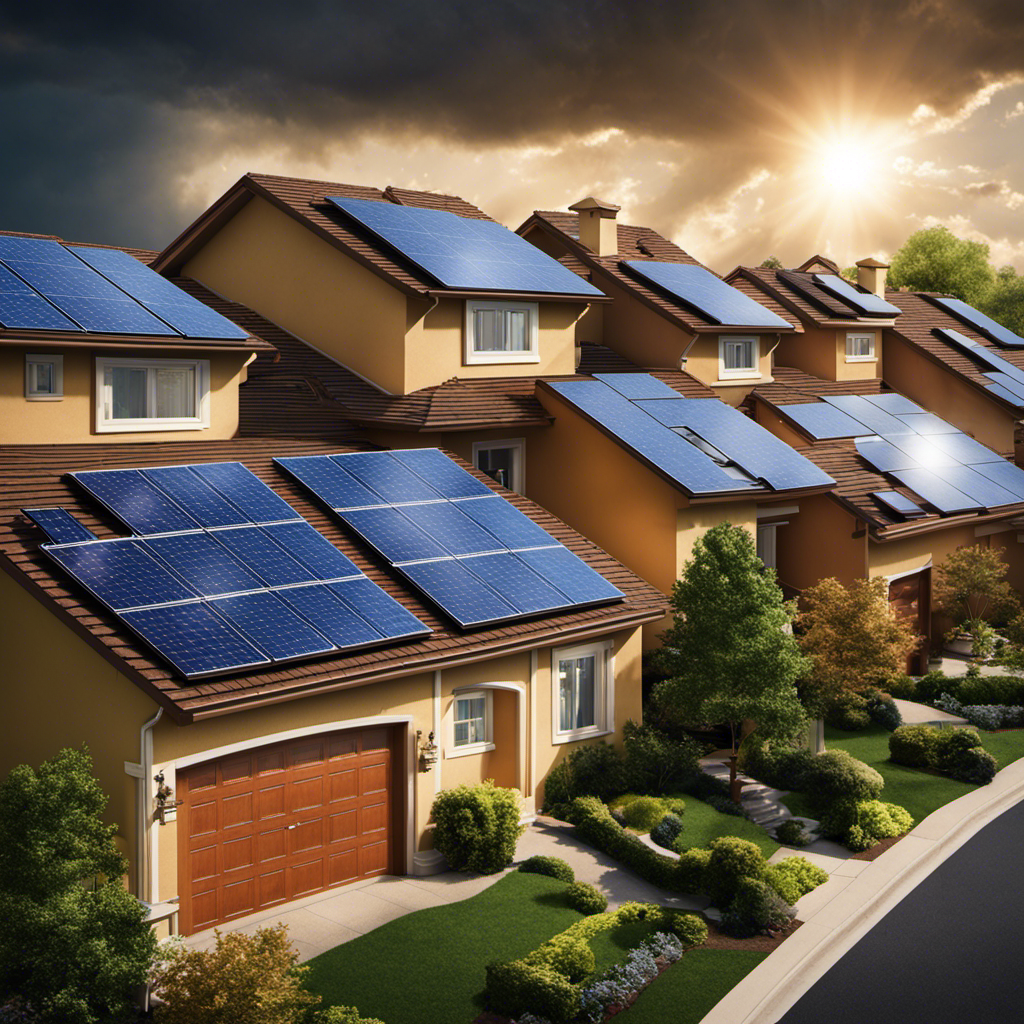Solar
Understanding Net Metering for Solar Power

I have to say, net metering for solar power is a game-changer. It’s like having the best of both worlds.
With net metering, you can generate your own electricity from solar panels and sell any excess power back to the grid. It’s all about giving power to the people and making renewable energy more accessible.
In this article, I’ll break down the ins and outs of net metering so you can understand how it works and why it’s so beneficial.
Key Takeaways
- Net metering allows residential solar power systems to connect to the grid and feed excess electricity back into it.
- Homeowners can offset their energy consumption and potentially earn credits on their utility bills.
- Net metering policies and regulations vary from state to state, determining the financial benefits and feasibility of installing a solar power system.
- Net metering provides ongoing financial benefits, reducing reliance on the grid and helping combat climate change.
The Basics of Net Metering
I’m learning about the basics of net metering and how it can benefit homeowners with solar power.
Net metering is a system that allows residential solar power systems to connect to the grid and feed excess electricity back into it. This is a significant advantage for homeowners because it allows them to offset their energy consumption and potentially earn credits on their utility bills.
With net metering, homeowners no longer have to worry about wasting the excess energy their solar panels produce during the day. Instead, they can use it later when there’s a higher demand or during the night when their panels aren’t generating electricity.
Net metering provides a seamless integration of solar power into the existing grid infrastructure, ensuring a more efficient and sustainable energy future.
Now let’s delve into how net metering works.
How Net Metering Works
I’ve learned that net metering allows me to earn credits for the excess solar energy my panels produce. It’s a great incentive that encourages the adoption of renewable energy sources like solar power. However, the implementation of net metering does come with its challenges. One of the main challenges is the need for advanced metering infrastructure that can accurately measure both the energy consumed and the energy produced. This requires investments in smart meters and communication systems. Additionally, net metering can have an impact on grid stability. When there is an abundance of solar power being fed into the grid during peak generation hours, it can strain the grid and potentially lead to voltage fluctuations. Grid operators need to carefully manage and balance the energy flow to ensure stability.
| Challenges | Impact on Grid Stability |
|---|---|
| Advanced metering infrastructure | Voltage fluctuations |
| Investment in smart meters | Strain on the grid |
| Communication systems | Need for careful energy management |
Understanding Net Metering Policies and Regulations
The policies and regulations surrounding net metering can greatly impact the adoption of renewable energy. Net metering is a system that allows solar power system owners to receive credit for the excess electricity they generate and feed back into the grid. These policies and regulations vary from state to state and can determine the financial benefits and feasibility of installing a solar power system.
Net metering regulations typically outline the eligibility requirements, compensation rates, and billing mechanisms for solar power system owners. Clear and favorable regulations can provide incentives for homeowners and businesses to invest in solar energy, as they can offset their electricity costs and even earn credits. On the other hand, restrictive regulations or the absence of net metering can discourage the adoption of solar power systems.
Understanding the advantages of net metering and advocating for supportive regulations is crucial to promote renewable energy growth.
This transition into the subsequent section about the benefits of net metering for solar power system owners will explore how net metering allows them to save money and contribute to a cleaner environment.
Benefits of Net Metering for Solar Power System Owners
As a solar power system owner, I can save money on my electricity bills and contribute to a cleaner environment through the benefits of net metering.
Net metering allows me to generate my own electricity using solar panels and feed any excess energy back into the grid. This surplus energy is credited to my account, offsetting the electricity I consume during times when my solar panels aren’t producing enough power.
The advantages of net metering are twofold: first, it provides significant savings potential by reducing my reliance on the grid and lowering my electricity costs. Second, it promotes the use of renewable energy sources, helping to reduce greenhouse gas emissions and combat climate change.
Net metering is an excellent incentive for solar power system owners, offering both financial benefits and environmental advantages.
Net Metering Vs. Other Solar Power Incentives
Compared to other incentives, net metering offers significant advantages for solar power system owners like me. Here are some reasons why net metering stands out:
-
Savings on electricity bills: Net metering allows me to offset my electricity consumption with the excess power produced by my solar panels. This significantly reduces my monthly electricity bills.
-
Financial incentives: Unlike other incentives that provide one-time payments or tax credits, net metering offers an ongoing financial benefit. I can earn credits for the excess electricity I generate and feed back into the grid.
-
Flexibility and convenience: Net metering allows me to use the grid as a virtual storage system. I can draw from the grid when my solar panels aren’t producing enough power, ensuring a continuous supply.
-
Environmental impact: By participating in net metering, I’m contributing to the reduction of greenhouse gas emissions and promoting a cleaner and more sustainable energy future.
-
Long-term investment: Net metering provides a long-term financial return on my investment in solar panels. Over time, the savings on electricity bills can offset the initial costs of installing the system.
While net metering offers numerous advantages, it’s important to acknowledge its limitations. These may include caps on system size, potential changes in net metering policies, and the reliance on a stable electric grid.
However, when considering the incentives available for solar power system owners, net metering remains a top choice due to its consistent and substantial benefits.
Frequently Asked Questions
What Are the Eligibility Criteria for Participating in a Net Metering Program?
To participate in a net metering program, you need to meet certain eligibility criteria. These criteria determine if your solar power system qualifies and how it will impact the value of your system.
How Does Net Metering Affect the Value of My Solar Power System?
Net metering greatly impacts the value of my solar power system. The benefits are evident in increased savings and reduced electricity bills. It’s a win-win situation that allows me to harness the full potential of my solar panels.
Are There Any Limitations on the Size of the Solar Power System That Can Participate in Net Metering?
There are limitations on the size of a solar power system that can participate in net metering. These limitations are based on the maximum system capacity allowed by the utility company.
Can I Sell Excess Solar Power Generated Under a Net Metering Program to My Neighbors or the Local Community?
Yes, I can sell excess solar power generated under a net metering program to my neighbors or the local community. This benefits the community by promoting renewable energy and reducing electricity costs.
How Does Net Metering Affect the Billing and Payment Process for Solar Power System Owners?
Net metering simplifies the billing and payment process for solar power system owners. It ensures that I only pay for the net energy consumed from the grid and receive credit for any excess energy generated.
Conclusion
In conclusion, net metering is a crucial policy for solar power system owners, allowing them to offset their energy costs and contribute to a cleaner environment.
One interesting statistic to note is that according to the Solar Energy Industries Association, around 38 states in the United States have implemented net metering policies, demonstrating its widespread adoption and recognition as an effective incentive for promoting renewable energy.
With its numerous benefits and increasing popularity, net metering continues to play a vital role in the growth of solar power.
Solar
Solar Energy and Sustainable Tourism: Powering Responsible Travel

As a fan of traveling, I have always supported the idea of responsible tourism. That is why I am excited to delve into the amazing connection between solar power and eco-friendly travel.
In this article, we’ll delve into how solar energy can revolutionize the tourism industry, from reducing our carbon footprint to powering accommodations.
Join me as we uncover the bright future of solar-powered travel and the positive impact it can have on our planet.
Get ready to embark on an eco-friendly adventure like never before!
Key Takeaways
- Solar energy in sustainable tourism reduces reliance on fossil fuels and minimizes carbon emissions.
- Implementing solar energy solutions in tourist destinations empowers local communities and creates opportunities for economic growth and job creation.
- Solar energy can help reduce the carbon footprint of travel through eco-friendly transportation and carbon offsetting programs.
- Solar-powered accommodations offer a responsible and immersive experience for travelers while supporting the growth of sustainable travel.
The Benefits of Solar Energy in Sustainable Tourism
I believe that solar energy plays a crucial role in promoting sustainability in the tourism industry.
Solar energy offers a multitude of advantages for sustainable tourism practices. Firstly, it’s a renewable and abundant source of energy, reducing reliance on fossil fuels and minimizing carbon emissions. By harnessing sunlight, tourism establishments can significantly reduce their environmental impact and contribute to the conservation of natural resources.
Solar energy also provides economic benefits, as it helps decrease operational costs in the long run. Additionally, it enhances the resilience of tourism facilities, ensuring a continuous power supply even in remote areas.
Implementing solar energy systems in the tourism industry not only reduces the environmental footprint but also enhances the overall visitor experience by providing a clean and sustainable energy source.
Implementing Solar Energy Solutions in Tourist Destinations
As an advocate for green initiatives, I believe integrating solar power in popular tourist destinations can lead to a more sustainable future.
Solar energy has the potential to empower local communities by promoting sustainable development. By implementing solar energy solutions, these communities can reduce their reliance on traditional energy sources, such as fossil fuels, and instead utilize clean and renewable energy. This not only helps to reduce carbon emissions and combat climate change, but also creates opportunities for economic growth and job creation within the community.
However, implementing solar energy in remote tourist destinations does come with its challenges. These challenges include limited access to resources, lack of infrastructure, and high upfront costs.
To overcome these challenges, it’s essential to collaborate with local governments, businesses, and organizations to develop funding mechanisms, provide technical assistance, and raise awareness about the benefits of solar energy. By doing so, we can pave the way for a greener and more sustainable tourism industry.
Reducing Carbon Footprint: Solar Energy and Sustainable Travel
By reducing our carbon footprint through the use of renewable resources, I believe we can contribute to a more environmentally friendly way of traveling.
Solar energy is one such renewable resource that has immense potential in powering eco-friendly transportation options. With solar panels installed on vehicles, such as buses and cars, we can harness the power of the sun to reduce our dependence on fossil fuels.
Additionally, carbon offsetting programs can help us mitigate the emissions produced by our travel activities. By investing in sustainable projects like reforestation or renewable energy, we can offset the carbon emissions associated with our travel, making it more sustainable.
Embracing solar energy and implementing carbon offsetting practices are crucial steps towards achieving a more sustainable and responsible approach to travel.
Solar-Powered Accommodations: A Step Towards Responsible Tourism
Staying in accommodations powered by the sun allows me to enjoy a more eco-friendly and sustainable travel experience. Eco-friendly resorts that incorporate solar-powered infrastructure are becoming increasingly popular among travelers who are conscious of their environmental impact.
These resorts utilize solar panels to generate electricity, reducing their reliance on fossil fuels and minimizing carbon emissions. Solar energy is a clean and renewable source of power, making it an ideal solution for sustainable tourism. By harnessing the sun’s energy, these resorts can provide guests with all the modern comforts without compromising the environment.
Solar-powered accommodations not only benefit the planet, but they also offer a unique and immersive experience for travelers who want to engage in responsible tourism. Choosing to stay in eco-friendly resorts helps support the growth of sustainable travel and contributes to a more sustainable future.
The Future of Sustainable Tourism: Solar Energy as a Game Changer
I believe that the use of solar panels in accommodations has the potential to revolutionize the way we travel. Not only does it provide a sustainable and eco-friendly alternative to traditional energy sources, but it also has significant economic benefits for tourist destinations. The role of government in promoting solar energy in tourism is crucial. By offering incentives and subsidies for the installation of solar panels, governments can encourage accommodations to adopt this renewable energy source. This not only reduces the carbon footprint of the tourism industry but also creates jobs and stimulates local economies. The economic impact of solar energy adoption in tourist destinations is substantial. It attracts environmentally conscious travelers who are willing to pay a premium for sustainable experiences. Additionally, solar-powered accommodations save money on energy bills, allowing businesses to reinvest in improving their services and infrastructure. It’s a win-win situation for both the environment and the economy.
| Benefits of Solar Energy in Tourism | ||
|---|---|---|
| Environmental Benefits | Economic Benefits | Government Role |
| – Reduces carbon footprint | – Cost savings for accommodations | – Provide incentives and subsidies |
| – Minimizes reliance on fossil fuels | – Job creation and economic stimulation | – Encourage adoption of solar energy |
| – Promotes sustainable practices | – Attracts environmentally conscious travelers | – Support research and development |
Frequently Asked Questions
How Does Solar Energy Contribute to the Local Economy in Tourist Destinations?
Solar energy contributes to the local economy in tourist destinations by creating local jobs and stimulating economic growth. It provides opportunities for renewable energy industries and attracts sustainable tourism, which benefits the community and the environment.
What Are Some Challenges of Implementing Solar Energy Solutions in Remote Tourist Destinations?
Implementing solar energy solutions in remote tourist destinations can be challenging due to limited infrastructure, high installation and maintenance costs, and lack of skilled labor. However, these challenges can be overcome through innovative financing models and capacity-building initiatives.
Are There Any Incentives or Government Programs Available to Support the Adoption of Solar Energy in the Tourism Industry?
Yes, there are government incentives and financial support available to support the adoption of solar energy in the tourism industry. These programs aim to encourage sustainable practices and reduce reliance on non-renewable energy sources.
How Can Solar-Powered Accommodations Ensure a Comfortable and Enjoyable Experience for Tourists?
Solar-powered accommodations can ensure a comfortable and enjoyable experience for tourists by integrating energy-efficient technologies. These include efficient insulation, solar water heating, and smart climate control systems that prioritize guest comfort while minimizing environmental impact.
What Advancements in Solar Energy Technology Can We Expect to See in the Future for Sustainable Tourism?
What advancements in solar energy technology can we expect in the future for sustainable tourism? How will these innovations revolutionize the way we power and experience responsible travel? Let’s explore the possibilities.
Conclusion
In conclusion, solar energy is a game changer for sustainable tourism.
By implementing solar energy solutions in tourist destinations and powering accommodations with solar power, we can significantly reduce our carbon footprint and promote responsible travel.
As the saying goes, ‘Every journey begins with a single step,’ and embracing solar energy is a crucial step towards a more sustainable future for the tourism industry.
Let’s harness the power of the sun to create a brighter and greener travel experience for all.
Solar
The Role of Solar Power in Disaster Resilience

As a disaster resilience researcher, I can assert that solar power plays a vital role in reducing the impact of emergencies.
When disaster strikes, having a reliable source of electricity is essential for communication, connectivity, and powering emergency shelters.
By harnessing the energy of the sun, we can enhance our resilience, ensuring sustainable recovery and reconstruction.
In this article, we will explore the various ways in which solar technology is revolutionizing disaster response and contributing to our overall preparedness.
Key Takeaways
- Solar power provides a continuous and reliable source of electricity during disasters.
- Solar technology enhances communication and connectivity in disaster-stricken areas.
- Solar-powered infrastructure and emergency shelters increase resilience during emergencies.
- Solar power contributes to sustainable disaster recovery and reconstruction efforts.
Harnessing Solar Energy for Emergency Power Supply
I can rely on solar energy for emergency power supply during disasters. Off grid solar solutions are an effective means of ensuring a continuous power supply when the traditional electrical grid is compromised.
Solar panels can be easily installed on rooftops or in open areas, harnessing the abundant energy from the sun. This energy can then be converted into electricity to power essential devices and appliances, such as lights, communication systems, and medical equipment.
Additionally, solar powered water purification systems can be utilized to provide clean drinking water in disaster-stricken areas. These systems use solar energy to power the filtration and disinfection processes, ensuring that water is safe for consumption.
Solar Power as a Reliable Source of Electricity in Disaster Situations
During emergencies, relying on solar energy ensures a steady supply of electricity. Solar power offers several benefits in disaster situations.
Firstly, it’s a renewable source of energy, making it sustainable and environmentally friendly.
Secondly, solar panels can be easily installed and require minimal maintenance, providing a reliable power source without the need for a complicated infrastructure.
Additionally, solar power can be harnessed even in remote areas, ensuring that electricity is available in hard-to-reach locations during disasters.
However, solar power does have its limitations. It relies on sunlight, meaning that it may not be as effective during cloudy or nighttime conditions.
Additionally, the initial cost of installing solar panels can be expensive.
Despite these limitations, solar power remains a valuable option for emergency power supply.
Moving forward, integrating solar technology for communication and connectivity in disasters can further enhance overall disaster resilience.
Integrating Solar Technology for Communication and Connectivity in Disasters
Integrating solar technology in communication and connectivity during emergencies enhances overall disaster preparedness. Solar power provides a reliable and sustainable source of energy that can be used to power communication devices and maintain connectivity in disaster situations. Here are three key benefits of integrating solar technology in emergency response:
-
Increased reliability: Solar-powered communication systems can function independently of the grid, ensuring that vital communication channels remain operational even during power outages.
-
Rapid deployment: Solar-powered communication equipment can be quickly deployed in disaster-stricken areas, providing immediate connectivity and enabling effective coordination of emergency response efforts.
-
Cost-effective solution: Solar-powered communication systems eliminate the need for fuel and reduce reliance on traditional power sources, resulting in significant cost savings over time.
By harnessing the power of the sun, solar technology plays a crucial role in enhancing resilience and improving overall disaster response capabilities.
Transitioning into the subsequent section, let’s explore how solar power can further enhance resilience with solar-powered emergency shelters and infrastructure.
Enhancing Resilience With Solar-Powered Emergency Shelters and Infrastructure
With solar technology, we can create emergency shelters and infrastructure that are more resilient and sustainable in the face of disasters. By incorporating solar powered water purification systems into these shelters, we can ensure access to clean and safe drinking water even in the most challenging situations.
These systems utilize solar panels to generate electricity, which in turn powers the water purification process, eliminating the need for external energy sources.
Additionally, solar powered medical equipment can be installed in these emergency shelters, providing essential healthcare services in times of crisis. These devices, such as solar powered refrigerators for storing vaccines and solar powered lights for surgical procedures, can operate independently of the grid, ensuring uninterrupted medical support.
Solar technology not only increases the resilience of emergency shelters, but also plays a crucial role in maintaining essential services during disasters.
Leveraging Solar Power for Sustainable Disaster Recovery and Reconstruction
I believe that incorporating solar technology into disaster recovery and reconstruction efforts can lead to more sustainable and efficient long-term solutions. By harnessing the power of the sun, we can significantly reduce our reliance on fossil fuels and mitigate the environmental impact of post-disaster operations.
Here are three ways in which solar power can be leveraged for sustainable disaster recovery and reconstruction:
-
Solar-powered water purification: Access to clean and safe drinking water is crucial during and after a disaster. Solar-powered water purification systems can provide a reliable source of clean water by using sunlight to disinfect and filter contaminated water, reducing the risk of waterborne diseases.
-
Off-grid power generation: During a disaster, traditional power grids often fail, leaving affected areas without electricity. Solar power can provide a reliable and decentralized source of energy, powering critical infrastructure such as hospitals, emergency shelters, and communication systems.
-
Renewable energy for rebuilding: Integrating solar panels into the design of rebuilt structures and infrastructure can ensure a sustainable and resilient energy supply. Solar energy can be used to power lighting, heating, and cooling systems, reducing reliance on non-renewable energy sources and lowering long-term operational costs.
Frequently Asked Questions
What Are the Main Challenges in Harnessing Solar Energy for Emergency Power Supply?
The main challenges in harnessing solar energy for emergency power supply are the limitations of solar panels, such as their dependence on sunlight and the need for adequate storage systems to maintain power during nighttime or cloudy conditions.
How Does Solar Power Compare to Traditional Sources of Electricity in Terms of Reliability During Disaster Situations?
During disasters, solar power proves more reliable than traditional sources of electricity due to its resilience benefits. It provides a stable and constant source of energy, reducing the dependence on vulnerable infrastructure.
Are There Any Limitations or Drawbacks to Integrating Solar Technology for Communication and Connectivity in Disasters?
There are several limitations and drawbacks to integrating solar technology for communication and connectivity in disasters. These include the dependency on sunlight, limited energy storage capacity, and potential damage to solar panels during extreme weather events.
What Are the Key Features and Benefits of Solar-Powered Emergency Shelters and Infrastructure?
Solar powered emergency shelters provide a reliable and sustainable source of energy in disasters. They offer benefits such as uninterrupted power supply, reduced reliance on fossil fuels, and increased resilience to power outages.
Can Solar Power Be Used Effectively for Long-Term Sustainable Disaster Recovery and Reconstruction Efforts?
Solar power can play a crucial role in long-term sustainable disaster recovery and reconstruction efforts. Its ability to provide clean and reliable energy can support communities in rebuilding and ensure resilience for future disasters.
Conclusion
In conclusion, the role of solar power in disaster resilience is crucial in providing a reliable source of electricity during emergencies.
One interesting statistic is that solar power systems have the potential to reduce greenhouse gas emissions by up to 80% compared to traditional power sources.
By integrating solar technology in communication, infrastructure, and emergency shelters, we can enhance resilience and promote sustainable disaster recovery and reconstruction.
Solar power isn’t only a practical solution, but also an environmentally friendly one.
Solar
The Role of Solar Energy in Sustainable Architecture

I am an architect who is deeply committed to designing eco-friendly buildings that have a minimal impact on the environment.
One crucial aspect of sustainable architecture is the use of solar energy.
In this article, we will explore the vital role that solar energy plays in sustainable architecture.
From integrating solar panels in building designs to employing passive solar design techniques, we will examine the various ways in which solar energy can be harnessed to create energy-efficient and environmentally friendly buildings.
Key Takeaways
- Solar energy reduces greenhouse gas emissions and provides a clean, renewable source of power.
- Integration of solar panels in buildings helps generate electricity on-site and lowers energy costs.
- Proper orientation of buildings and passive solar design techniques maximize energy efficiency and reduce reliance on artificial lighting and heating systems.
- Solar energy implementation reduces carbon footprint in transportation, agriculture, and food production, contributing to a more environmentally friendly future.
Benefits of Solar Energy in Sustainable Architecture
I believe that incorporating solar energy into sustainable architecture offers numerous benefits.
Solar energy plays a crucial role in urban planning, as it provides a clean and renewable source of power that reduces greenhouse gas emissions. By integrating solar panels into buildings, we can generate electricity on-site, reducing the reliance on fossil fuels and lowering energy costs.
Additionally, solar energy can contribute to achieving green building certification standards, such as LEED, by demonstrating a commitment to sustainability and environmental responsibility. Solar-powered buildings can also act as energy-efficient models, inspiring others to follow suit and contribute to a more sustainable future.
Moreover, solar energy systems provide a reliable and resilient source of power, reducing the vulnerability of buildings to power outages and ensuring a continuous supply of electricity.
Overall, incorporating solar energy into sustainable architecture offers a multitude of benefits, from reducing carbon emissions to promoting energy efficiency and resilience.
Integration of Solar Panels in Building Designs
As an architect, I believe that incorporating solar panels into building designs is crucial for achieving energy efficiency and reducing carbon emissions. When it comes to solar panel placement, it’s important to consider factors such as the orientation and tilt of the building, as well as potential obstructions that may cast shadows on the panels.
Ideally, solar panels should be installed on south-facing roofs with a tilt angle that maximizes sunlight exposure throughout the day. Additionally, integrating solar powered ventilation systems can further enhance the energy efficiency of a building. By using solar energy to power ventilation fans, the building can reduce its reliance on traditional energy sources and decrease its carbon footprint.
Therefore, carefully considering solar panel placement and incorporating solar powered ventilation can greatly contribute to sustainable architecture and a greener future.
Passive Solar Design Techniques for Energy Efficiency
Passive solar design techniques utilize natural sunlight and heat to maximize energy efficiency in buildings. By incorporating solar shading strategies and daylighting techniques, buildings can significantly reduce their reliance on artificial lighting and heating systems.
Here are some key strategies to consider:
-
Orientation: Properly orienting a building to maximize exposure to the sun can optimize passive solar heating and cooling.
-
Insulation: Adequate insulation helps to minimize heat loss during the colder months and heat gain during the hotter months.
-
Thermal Mass: Incorporating materials with high thermal mass, such as concrete or stone, can store and release heat to maintain a comfortable temperature.
-
Glazing: Using high-performance glazing with low-emissivity coatings and appropriate shading devices can control solar heat gain and maximize daylighting.
Solar Water Heating Systems for Sustainable Buildings
Installing a solar water heating system can greatly reduce my reliance on traditional energy sources and contribute to a more sustainable and eco-friendly building. Not only is solar energy abundant and renewable, but it can also save me money in the long run.
Solar water heating systems are cost-effective because they use the sun’s energy to heat water, reducing the need for electricity or gas. While the initial installation cost may be higher, the savings on energy bills over time can make up for it.
Additionally, maintenance requirements for solar water heating systems are relatively low. Regular inspections and cleaning are recommended to ensure optimal performance, but overall, they’re reliable and durable.
With proper care, a solar water heating system can provide hot water efficiently for many years, making it a smart and sustainable investment.
Reducing Carbon Footprint Through Solar Energy Implementation
By implementing solar energy systems, I can significantly reduce my carbon footprint and contribute to a more environmentally friendly future. Solar energy has the potential to revolutionize transportation and agriculture, two industries that contribute significantly to greenhouse gas emissions. Here are some ways solar energy can make a positive impact:
-
Solar energy in transportation: Solar-powered vehicles, such as electric cars and buses, can reduce the reliance on fossil fuels and decrease emissions. Additionally, solar charging stations can provide renewable energy for electric vehicles, making them even more sustainable.
-
Solar energy in agriculture: Solar panels can be installed on farms to generate clean energy for irrigation systems and other agricultural processes. This reduces the need for fossil fuel-powered machinery and decreases the carbon footprint of food production.
-
Solar-powered water pumping: Solar energy can be used to power water pumps in remote agricultural areas, reducing the reliance on diesel generators and promoting sustainable irrigation practices.
-
Solar energy in food processing: Solar-powered systems can be used in food processing facilities, reducing the energy consumption and carbon emissions associated with food production.
Frequently Asked Questions
How Much Does It Cost to Install Solar Panels in a Sustainable Building?
Installing solar panels in sustainable buildings can vary in cost depending on factors such as solar panel efficiency and government incentives. However, it is an investment that can lead to long-term savings and contribute to a more sustainable future.
Can Solar Energy Be Used as the Primary Source of Energy in a Building?
Yes, solar energy can be used as the primary source of energy in a building. Its efficiency and the benefits of solar power make it a viable option for sustainable architecture.
Are There Any Limitations to Integrating Solar Panels Into Building Designs?
There are both advantages and disadvantages to integrating solar panels into building designs. While they can provide clean and renewable energy, limitations such as cost and space requirements need to be considered.
What Are the Main Factors to Consider When Implementing a Solar Water Heating System in a Sustainable Building?
When implementing a solar water heating system in a sustainable building, factors to consider include location, orientation, efficiency, and maintenance. Proper planning and installation are key to maximizing the system’s effectiveness and reducing environmental impact.
How Can Solar Energy Implementation Effectively Reduce the Carbon Footprint of a Building?
Implementing solar energy effectively reduces a building’s carbon footprint by harnessing renewable energy. Solar energy reduces greenhouse gas emissions and decreases energy consumption in buildings, making them more sustainable and environmentally friendly.
Conclusion
In conclusion, it’s clear that solar energy plays a vital role in sustainable architecture.
From integrating solar panels in building designs to using passive solar design techniques, the benefits are undeniable.
Solar water heating systems also contribute to the overall sustainability of buildings.
By reducing our carbon footprint through solar energy implementation, we not only save money but also contribute to a greener future.
So let’s embrace the power of the sun and shine a light on sustainable architecture!
-

 Sustainable Supply Chain Management5 months ago
Sustainable Supply Chain Management5 months agoManagEnergy Acquires GPST2030.org Domain to Strengthen Commitment to Sustainable Transport
-

 Wind Energy5 months ago
Wind Energy5 months agoHow Much Oil Does It Take To Lubricate A Wind Turbine
-

 Electric Motorbike3 months ago
Electric Motorbike3 months agoCalifornia Electric Motorcycle Laws: A Comprehensive Guide to Riding Safely
-

 Solar4 months ago
Solar4 months agoIn 2009, About What Percent Of U.S. Energy Consumption Was Supplied By Solar Energy
-

 Electricity Vehicle3 months ago
Electricity Vehicle3 months agoThe Future of Electric Vehicles: Trends and Innovations to Watch
-

 Wind Energy3 months ago
Wind Energy3 months agoRevolutionizing Highways: Wind Turbines Take the Road to Renewable Energy
-

 Solar4 months ago
Solar4 months agoWhy Should We Use Solar Energy Instead Of Fossil Fuels
-

 Wind Energy4 months ago
Wind Energy4 months agoWhat Is The Minimum And Maximum Wind Speed For Operating A Wind Turbine

















